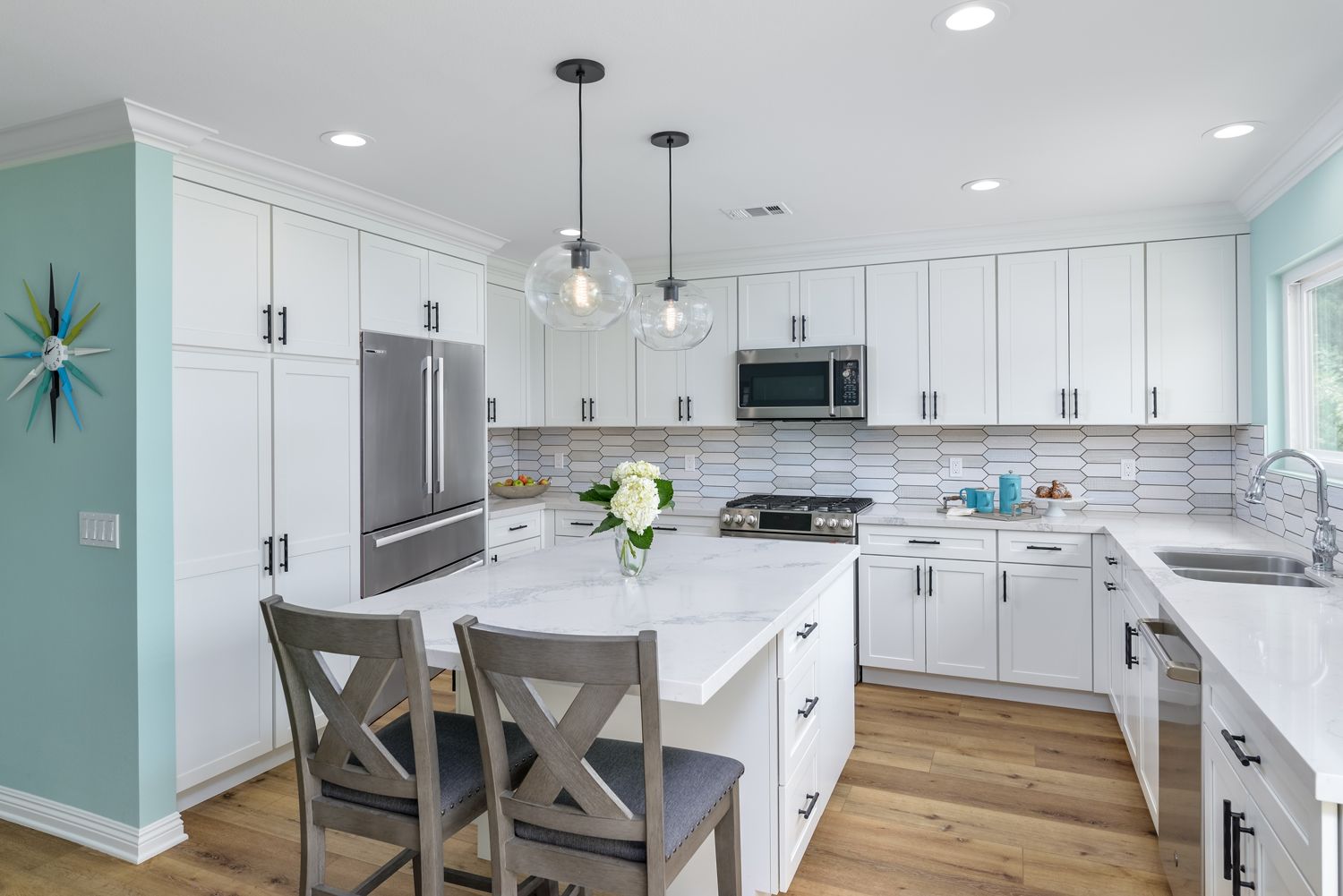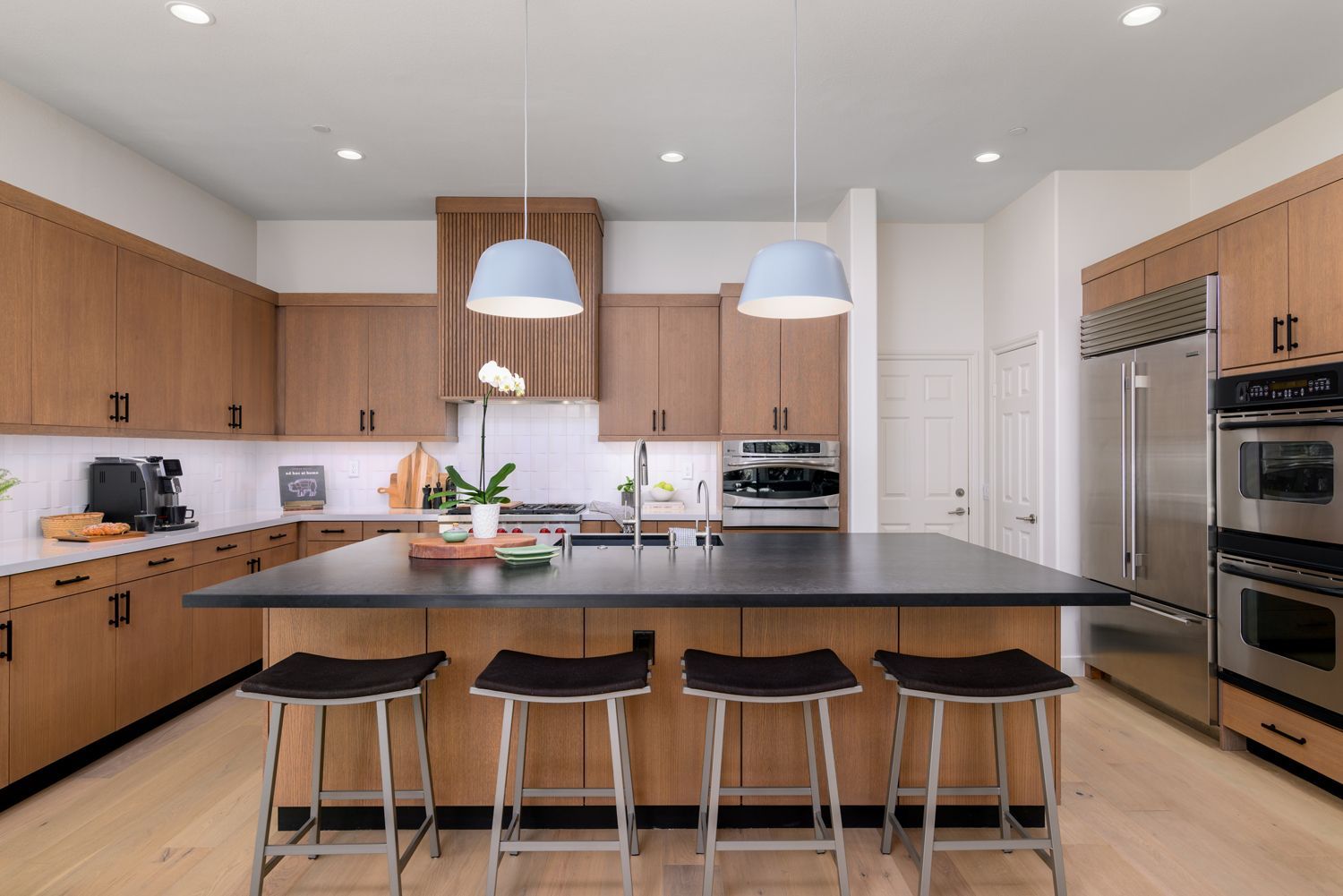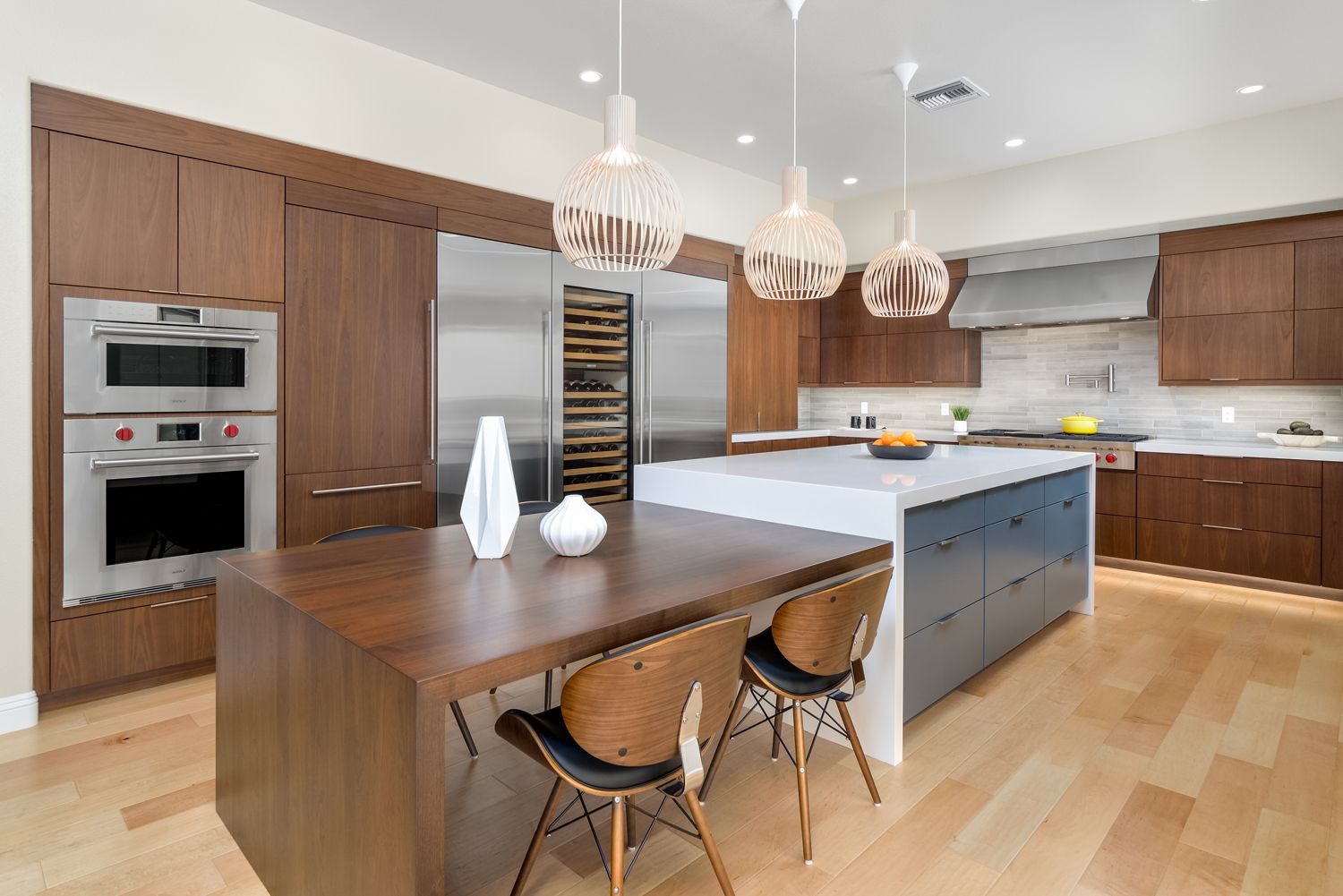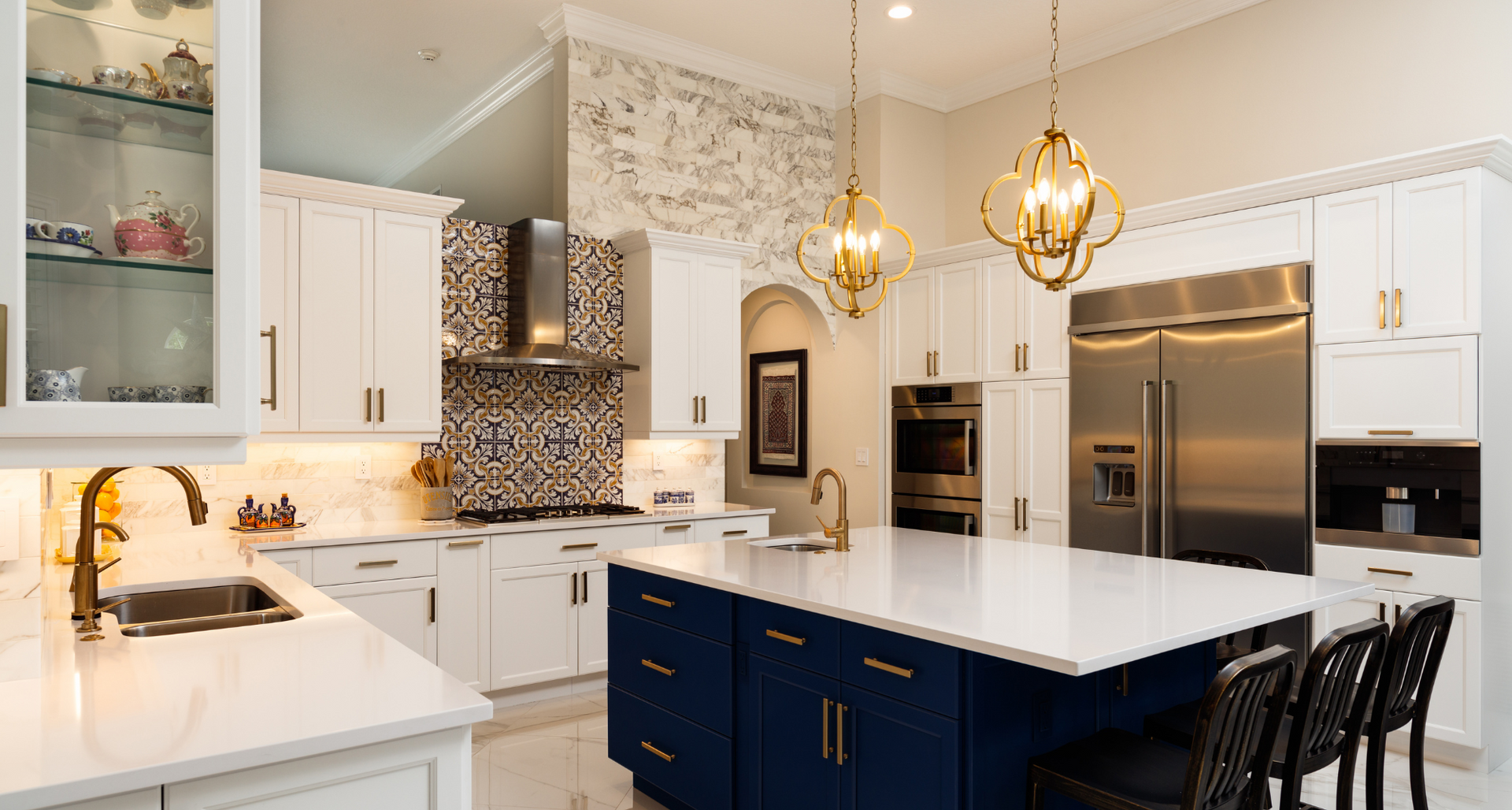How Much Does a Kitchen and Bath Remodel Cost in California
Kitchen Remodeling Costs in California: A Homeowner’s Guide
Considering a kitchen upgrade? You may be asking yourself, what does it cost to remodel a kitchen in California? When you embark on a kitchen improvement project, it's crucial to understand the financial implications before diving in.
Arm yourself with the invaluable insights offered by Westside Remodeling's kitchen remodeling cost guide. As a highly recommended design-build firm, we have cemented our reputation for excellence in kitchen and bathroom remodeling. We've leveraged our decades of expertise to create this comprehensive guide, designed to illuminate the costs associated with kitchen remodeling in California.
This indispensable resource empowers homeowners like you to make informed decisions when planning and budgeting for your kitchen renovation project. With the confidence that comes from knowledge and understanding, you can turn your dream kitchen into a reality without the worry of unanticipated costs. Trust in our authority, benefit from our expertise, and finally answer the question, "What is the kitchen remodeling cost in California?"
Table Of Contents:
- Understanding Kitchen Remodeling Costs in California
- The Impact of Scope of Work on Cost
- Minor vs Intermediate vs Major Projects
- Minor Kitchen Remodels
- Intermediate Kitchen Remodels
- Major Kitchen Remodels
- How Material Choices Influence Kitchen Remodeling Costs
- Selecting High Quality Materials
- Cabinetry
- Countertops
- Kitchen Size and Your Remodeling Budget
- Large Kitchens
- Smaller Kitchens
- Calculating Your Remodeling Costs
- Role of Location in Determining Kitchen Remodeling Costs
- Choosing the Right Remodeling Partner
- Wrapping Up Your Kitchen Remodeling Project
- Why Choose Westside Remodeling?
Understanding Kitchen Remodeling Costs in California
If you're planning a kitchen remodel in the scenic California, careful budgeting is essential. Expenses can fluctuate significantly depending on numerous elements, so it's important you understand the potential costs of your project at the very start.
According to Remodeling Magazine’s 2023 Cost vs Value Report, the average range for a midscale kitchen remodel in southern California is between $75,000 to $85,000. This figure will vary greatly depending on many factors, with the scope of work involved topping the list.
The Impact of Scope of Work on Cost
A critical factor influencing the cost of your kitchen remodel is the scope of work the project encompasses. Simpler projects with a limited scope tend to have lower expenses rather than those involving extensive structural modifications or larger square footage. Also, the complexity of the remodel, including the level of customization and the materials selected, will have a direct impact on the cost.
Minor vs Intermediate vs Major Projects
A critical factor influencing the cost of your kitchen remodel is the scope of work the project encompasses. Simpler projects with a limited scope tend to have lower expenses rather than those involving extensive structural modifications or larger square footage. Also the complexity of the remodel, including the level of customization and the materials selected, will have a direct impact on the cost.
Understanding the distinctions between minor, midrange, and major kitchen remodels can provide valuable perspective when determining the cost of your project.
- A minor kitchen remodel preserves the existing design and layout of the kitchen while giving it a surface-level makeover. The scope of work for a minor remodel usually involves refinishing or refacing the existing cabinets and updating the knobs and pulls. Other cosmetic enhancements like a new countertop, backsplash and new sink may be included.
- The cost for a minor kitchen remodel generally falls between $30,000 to $50,000.
- A midrange kitchen remodel may have minor structural changes but usually the basic floor plan stays in place. A typical intermediate kitchen remodel will include new cabinetry, countertops, backsplash, sink, and lighting upgrades. Appliances may be replaced and new floors installed—or the existing flooring patched as needed.
- The average cost for an intermediate kitchen remodel is between $80,000-$110,000.
- A major kitchen remodel will entail a complete overhaul of the space. This type of project may involve completely redesigning and/or expanding the kitchen, including modifying walls or making other structural changes. A major renovation project also incorporates new luxury elements such as high-quality cabinetry complete with customized storage features, engineered quartz or natural stone countertops, top of the line appliances, new flooring, upgraded lighting features such as chandeliers, and other upscale amenities.
- The cost for a major/upscale kitchen remodel is between $120,000-$150,000.
Minor Kitchen Remodels
If you're looking to give your kitchen a fresh, updated look without breaking the bank or changing its overall layout, a minor kitchen remodel might be just what you need. This type of renovation is typically more budget-friendly and involves surface-level updates rather than significant structural changes.
What Does a Minor Kitchen Remodel Include?
A minor kitchen remodel often encompasses refreshing the existing cabinetry and hardware, and/or replacing the countertops and backsplash. A typical minor kitchen remodel includes:
- Cabinet Refinishing or Refacing: For cabinets in good condition, refinishing or refacing them by a professional will give them a stylish new look at a more affordable cost. Cabinet refinishing involves painting or staining the existing cabinets (the style of the cabinets will stay the same). A reface entails swapping out the cabinet doors and drawer fronts with new ones and painting or staining the frames to match (the style of the cabinets can be updated). Cabinet glides and hinges are often replaced and storage features may be added.
- Countertops and Backsplash: If the existing cabinets are kept in place, the countertops and backsplash will be left intact. But if these features are out of style, installing beautiful new quartz countertops and a complementing backsplash can breathe new life into an outdated space.
- New Cabinet Hardware: Another way to spruce up your kitchen for a minimal cost is to update the cabinet hardware. Swapping out the knobs and pulls in a more trending style can make a big difference in your kitchen’s overall appearance.
- New Appliances: Upgrading old appliances may be part of a minor kitchen remodel, if the budget allows. Replacing some or all of the appliances will improve the efficiency of your kitchen and add a modern touch.
- Additional Upgrades: Other elements that can instantly refresh your kitchen while being easy on the budget are new light fixtures and a new sink. A fresh coat of paint on the walls will instantly make your space look brighter and more spacious.
Note that the materials selected for minor kitchen remodels will be more budget friendly and not high-end. The focus here is on improving aesthetics without overspending.
Choosing a Minor Kitchen Remodel
In terms of cost-effectiveness, minor remodeling projects offer great value for the money as they significantly improve both form and function within reasonable budgets. They are also more convenient than medium and major remodels as there is less work involved. The result is a shorter timeline, fewer workers and less dust in your house. The price range for such projects in California generally falls between $30,000 - $50,000 depending upon factors like scope of work and material selections.
Investing in a minor kitchen remodel can enhance your home's value, making it an excellent choice for homeowners planning to sell their property soon. It also provides the opportunity to make those small changes that have been on your wish list, creating a space you love without undertaking a full-scale renovation. It is important to have a professional firm that is experienced in cabinet restoration, such as Westside Remodeling, refinish or reface your cabinets.

Intermediate Kitchen Remodels
An intermediate kitchen remodel is more involved than a simple refresh. For this type of project, the space is typically redesigned for better function and flow. All new cabinetry, countertops, appliance, flooring and lighting are usually included. And new features, such as a new island or buffet cabinet, may be introduced.
- New Cabinetry and Hardware: For an intermediate kitchen remodel, new cabinetry will play the biggest role in determining the layout, style and budget of the project. A typical midscale kitchen remodel will include nice quality cabinetry with customized storage features and accessories. There are a wide range of styles and finishes available to choose from. Cabinet hardware in a stylish finish is installed once the cabinets are in place.
- Countertops and Backsplash: New countertops and a new backsplash are included in a midscale project. Engineered quartz is the most popular countertop selection followed by natural stone, such as granite. A butcher block (wood) countertop may be selected for the island. The backsplash is also an important feature to determine the style of the kitchen. Tile is the is the most common choice with a huge selection available. Backsplashes in the same quartz material as the countertops is also popular for a clean, modern look.
- Lighting Upgrades: For a medium range project, lighting that is stylish and energy efficient will be incorporated. Often, the existing light sofit is removed and recessed lighting incorporated. Decorative light fixtures over the kitchen island, such as two or three elegant pendant lights, will make a big impact on the style of your kitchen.
- Plumbing Fixtures: A new sink-such as a farmhouse sink, a new faucet and maybe a beverage bar is included in a midrange kitchen remodel.
- Appliances: New energy efficient appliances may be included in a midscale kitchen remodel. Appliances may be relocated if a new layout is incorporated.
- Flooring: New flooring, such as wood, tile, natural stone or luxury vinyl may be installed. Or the existing flooring may just be patched as needed.
Opting for an Intermediate Kitchen Remodel
An intermediate kitchen remodel is perfect for California homeowners who want their kitchen to be more functional, stylish and energy efficient. With a typical budget ranging from $80,000-$110,000, an intermediate remodel can transform your kitchen into a more attractive and enjoyable space while adding value to your home. Be sure to hire a trusted and experienced design-build firm like Westside Remodeling to plan and construct your midscale kitchen renovation.

Major Kitchen Remodels
If you're considering a total transformation of your kitchen, be prepared for a comprehensive project that will change the entire look and feel of your space. A major kitchen remodel is more than just updating appliances or replacing countertops - it's an extensive renovation that may involve completely changing the layout, expand the area and incorporating all new high-end materials and appliances. This type of renovation often involves several key elements:
- Redesigning or expanding the space: This may involve modifying walls or making other structural changes to create better flow, open the kitchen to an adjoining room and/or to increase the size of the kitchen.
- Luxury countertops and backsplashes: The use of premium materials like granite or quartz for countertops adds a touch of elegance and durability. Marble may be selected for the backsplash, or quartz that looks like marble.
- High-end appliances: Incorporating high-quality, premium appliances not only enhances functionality but also contributes to the overall aesthetics of your kitchen.
- Smart appliances: Integrating smart appliances into your kitchen brings convenience and efficiency to a whole new level. With features like remote control, voice command, and automated settings, smart appliances make cooking and managing your kitchen tasks easier than ever before.
- Fully custom cabinets: Bespoke cabinetry provides personalized storage options tailored to suit your specific needs. Custom cabinets maximize space utilization while maintaining an appealing design aesthetic.
- New flooring: An essential part of any major remodel, new flooring can dramatically alter the look and feel of your kitchen. Popular selections include hardwood, natural stone and tile.
- Upgraded lighting features: Beautiful, energy-efficient lighting is crucial in any kitchen design. Incorporating stylish fixtures like recessed lighting, pendant lights, or chandeliers can add beauty, luxury, and increased efficiency to your space.
- Other upscale amenities: Additions such as wine coolers, warming drawers, pot fillers, etc., not only add to the functionality of your space, they also give your kitchen a high-end look and feel.
Deciding on a Major Kitchen Remodel
A major kitchen remodel generally costs between $120,000 and $150,000. A major renovation project will completely transform the look and feel of your space. But it's important to remember a project like this is a significant financial investment that requires careful planning and execution. As such, it's vital to partner with a knowledgeable and experienced design-build firm like Westside Remodeling.

Key Takeaway
The type of kitchen remodeling project you choose—minor, intermediate, or major—should align with your budget, needs, and the level of transformation you seek in your space. Minor remodels are cost-effective and involve surface-level updates. Intermediate remodels offer both aesthetic and functional updates. Major remodels involve a complete overhaul of your kitchen, incorporating luxury elements and structural upgrades.
Other Considerations
Before you embark on your kitchen remodeling project in California, there are a few additional considerations to take into account. Relocating appliances, rerouting plumbing, and removing structural walls, for example, can significantly influence the overall cost and timeline of your renovation process.
Relocating Plumbing and Appliances
A major kitchen remodel generally costs between $120,000 and $150,000. A major renovation project will completely transform the look and feel of your space. But it's important to remember a project like this is a significant financial investment that requires careful planning and execution. As such, it's vital to partner with a knowledgeable and experienced design-build firm like Westside Remodeling.
Likewise, relocating major appliances like the refrigerator, range, or dishwasher can also increase your remodeling cost. These appliances often require specific electrical outlets or plumbing connections. For example, moving a refrigerator to a new location may require the installation of a new water line for the ice maker and water dispenser. Similarly, relocating a gas stove would require rerouting the gas line, which can be complex and costly. Additionally, some heavy appliances may require structural modifications to support their weight in their new locations.
Removing Structural Walls
A more open-concept kitchen often involves taking down structural walls – an undertaking that requires professional expertise due to its impact on home safety and structural integrity. This process may be complex and costly, but removing walls in your kitchen could help you achieve the bright, airy space you're dreaming of.
Budget considerations include structural engineer services, potential reinforcement needs, permitting and inspection requirements, labor and material costs, design changes, and any incidental costs. Effective planning and budgeting are crucial for a successful kitchen remodeling project involving structural changes.
At Westside Remodeling, we handle all aspects of the remodeling project, including relocating appliances, rerouting plumbing and structural modifications.
Key Takeaway
When planning a kitchen remodeling project, it is important to consider the potential costs and complexities associated with relocating plumbing and appliances, as well as making structural modifications like removing walls. These factors can significantly impact the overall cost, timeline, and success of the renovation.
How Material Choices Influence Kitchen Remodeling Costs
The materials you choose can have a significant impact on your remodeling costs. Opting for higher-end materials such as quartz countertops or hardwood flooring will undoubtedly add a luxurious touch but can increase your remodeling expenses. Choosing more affordable options can help keep costs down but may not offer the return on investment you're expecting.
Understanding how different material choices influence kitchen remodeling costs is essential in planning a successful and budget-friendly renovation.
Selecting High Quality Materials
When planning a kitchen remodel in California, one of the most critical decisions you'll make involves selecting high-quality materials. Your choice of materials can significantly impact both the aesthetic appeal and functionality of your kitchen.
The Impact on Aesthetics
Your chosen materials will set the tone for your entire kitchen's design. For instance, choosing real hardwood flooring over less expensive options can create a warm and inviting atmosphere. Likewise, opting for quartz countertops instead of laminate can elevate your kitchen's look to sophisticated elegance. It is essential to select quality materials that align with your desired style while enhancing the overall visual appeal.
Durability Matters
Beyond aesthetics, using high-quality materials ensures durability - an important factor considering how much use kitchens get daily. Investing in durable surfaces like engineered quartz or natural stone countertops means less worry about scratches or stains damaging their appearance over time. Choosing quality cabinets with durable finishes, like Westside Remodeling’s DuraSupreme, Omega and Kemper, ensures your cabinets will last for many years to come.
The Role in Functionality
In addition to visual appeal and longevity, quality material selection also plays into functional aspects such as maintenance needs and comfort levels when cooking or cleaning up after meals. For example, non-porous countertop options like quartz are easy-to-clean and care for compared to porous materials, which require regular sealing against spills and stains.
Cabinetry
When it comes to kitchen remodeling in the California, cabinetry is major factor in terms of aesthetics and functionality—and budget. Kitchen cabinets are often 30%, 40%, or even 50% of your overall renovation budget. As with other aspects of your kitchen remodel, cabinetry costs vary, depending on your choice of style, design, material, finishes and customization.
Cabinet Refacing
Cabinet refacing is a cost-effective way to give your kitchen a fresh, updated look at a fraction of the cost of installing all new cabinets. The process involves replacing the doors and drawer fronts of your existing cabinets, while keeping the cabinet boxes intact. Cabinet hardware including knobs, pulls, hinges and glides can be updated as well.
Semi-Custom Cabinets
If you're looking for more flexibility without breaking the bank, semi-custom cabinets could be your best bet. They offer a broader range of styles, finishes and modifications than stock options while still being relatively cost-effective.
Custom Cabinets
The priciest among these three categories are custom cabinets. Made-to-order based on specific dimensions and design preferences, they ensure unique aesthetics along with maximum space utilization - perfect if you have distinct requirements or want something truly one-of-a-kind.
Cabinet Materials and Design Upgrades
Your choice of cabinet material also significantly impacts costs. Common materials include wood veneer (mid-range) and solid wood (most expensive). Additionally, design upgrades like glass doors or intricate detailing will increase prices as well.
Innovative Storage Solutions
To optimize storage efficiency in your new kitchen layout consider incorporating features such as rollouts (pull-out shelves/drawers), lazy Susan's (rotating trays), spice racks etc., into your cabinetry plan.
While these additions may increase initial expenses, their long-term benefits regarding improved accessibility and organization make them worthwhile investments.
Whether you're planning a minor update or a full-scale kitchen remodel in the California area, understanding these cabinetry costs can help you budget wisely. Contact Westside Remodeling for expert guidance on choosing the perfect cabinets for your new kitchen.
Countertops
When it comes to kitchen remodeling in California, one of the major factors that affect the overall cost is your choice of countertops. Countertops not only serve a functional purpose but also contribute significantly to the aesthetic appeal of your kitchen.
Type and Quality of Material
The type and quality of material you choose for your countertops play a major role in determining the cost. Options range from laminate, which is relatively inexpensive but less durable, to natural stone materials like granite or marble which are more costly but can last a lifetime with proper care. Westside Remodeling offers an extensive selection of countertop materials suitable for various budgets and design preferences. These are some of our clients' favorites:
- Engineered Quartz: Durable, low-maintenance with an abundance of colors and patterns to choose from. The cost of quartz is comparable to granite—with the exception of some luxury styles.
- Granite and other natural stone: Durable, elegant, and natural. Wide range of colors and patterns. Cost is comparable to quartz.
- Concrete: Unique and customizable look. Contemporary aesthetic, mid to higher cost.
Other Factors in Countertop Costs
Beyond just purchasing raw materials, homeowners should also consider other related costs when calculating their budget for new countertops.
- Installation complexity: Some materials (eg. concrete) require specialized installation.
- Edge profiles: Different profiles (e.g. beveled, bullnose) may incur additional charges.
- Size and layout: Kitchen size and layout impact material needed and costs.
- Backsplash: Including a matching or contrasting backsplash adds to the budget.
- Maintenance and durability: Consider long-term costs associated with maintenance.
Key Takeaway
When planning a kitchen remodeling project, carefully consider your choices for countertops, cabinets, and other materials, as these selections have a significant impact on your overall costs. Prioritize durability, functionality, and your budget to strike a balance between quality and affordability in each category.
Kitchen Size and Your Remodeling Budget
The size of your kitchen plays a significant role in determining the overall cost of your remodeling project. Larger kitchens mean more square footage to cover, which generally translates to higher costs for materials and labor.
Large Kitchens
Remodeling a larger kitchen will naturally require more materials all around—including cabinets, countertops, flooring, and paint, all of which can add up quickly.
Additionally, if you have a large kitchen and want to change the layout—like moving appliances or plumbing around—that can significantly increase your remodeling costs due to the additional labor and potential infrastructure changes required.
Smaller Kitchens
While smaller kitchens projects may inherently cost less due to their reduced square footage, they also present unique challenges. For instance, maximizing space and functionality becomes a priority, which might necessitate custom solutions. These custom designs and installations can be more expensive than standard options.
Regardless of the size of your kitchen, careful planning is essential. It's important to create a budget that takes into account the size of your kitchen and allocate funds accordingly, considering all aspects from materials to labor costs. By doing so, you can ensure that your kitchen remodel meets your expectations without breaking the bank.
Calculating Your Remodeling Costs
Calculating your kitchen remodeling cost based on the square footage of your kitchen is a useful approach to estimate your budget. Here's a step-by-step guide:
Step 1: Measure Your Kitchen
Begin by measuring your kitchen to determine its square footage. You can do this by measuring the length and width of the room and then multiplying these dimensions. For example, if your kitchen is 12 feet long and 10 feet wide, the square footage is 120 square feet (12 ft x 10 ft.)
Step 2: Determine the Scope of Your Project
Decide on the scope of your kitchen remodeling project. Consider whether you're doing a major renovation, including structural changes, or just making minor updates. The extent of the work you plan to do will greatly influence your costs.
Step 3: Set a Budget Range
Before diving into specific costs, establish a budget range based on your kitchen's square footage. A common rule of thumb is to allocate 5% to 15% of your home's current value for a kitchen remodel. The square footage can help you narrow down this range. For example, if your kitchen is 120 square feet and your home is valued at $500,000, you might budget between $25,000 and $75,000 for the project.
Step 4: Break Down Costs
Begin getting an idea of the general break down of costs, including the main categories of materials, appliances, labor, and structural changes. You likely won't have specifics here, and that's okay at this stage.
Step 5: Get Quotes and Adjust the Budget
Now that you have a rough estimate for each cost category, it's time to get quotes from a design-build firm. Sharing the square footage and the scope of work you have in mind for your kitchen will enable the contractor to calculate an initial estimated budget range. Once you agree on the budget range, the design-build firm can fine tune your estimate as you work together to devise a design plan and make material selections.
Key Takeaway
The size of your kitchen is a key factor in determining the cost of your remodeling project. Larger kitchens require more materials and labor, while smaller kitchens may need custom solutions for maximizing space. Regardless of the size, careful planning and budgeting are essential. Calculate your budget based on the square footage of your kitchen and get quotes from professionals to ensure accurate estimates.
Role of Location in Determining Kitchen Remodeling Costs:
A Focus on California
Location plays a crucial role in determining the cost of a kitchen remodeling project. Factors such as local labor rates, availability and cost of materials, and even the local real estate market can influence the overall cost.
The California area in Southern California is known for its high standard of living and upscale real estate. As a result, kitchen remodeling costs in this area tend to be higher than the national average. The expectation for high-quality materials and craftsmanship in this region also contributes to a higher remodeling price tag.
Cost of Living
Living in California is pricier than many other areas, affecting everyday expenses like construction materials, labor, and transportation. Anticipate higher costs for kitchen remodeling compared to regions with a lower cost of living.
Housing Market
The California real estate market affects remodeling costs. In a competitive market, homeowners often invest more in home improvements to increase property value. This can drive up costs as demand for high-quality materials, custom designs, and professional contractors rises.
Labor Costs
Skilled labor, like carpenters, electricians, and plumbers, is pricier in high-cost-of-living areas. In California, where construction and renovation projects are booming, the cost of skilled tradespeople are higher. This can greatly impact your remodeling budget's labor costs.
Local Regulations
Building codes, zoning regulations, and permitting requirements vary by location. In California, strict building codes apply, particularly due to earthquake risks. Compliance may incur additional costs like engineering assessments, permits, and inspections.
Availability of Materials
The availability of construction materials can also influence costs. In some regions, certain materials may be more readily available, while in others, you may need to source materials from a distance. Transportation and procurement costs can impact the overall budget.
Environmental Factors
California, in general, places a strong emphasis on environmentally friendly and energy-efficient building practices. Adhering to these standards, which are prevalent in California, might require the use of more expensive eco-friendly materials and installation methods.
In summary, the cost of kitchen remodeling in California and nearby locations is subject to various location-specific factors, including the high cost of living, competitive real estate market, stringent regulations, labor expenses, and the availability of materials. It's crucial for homeowners in this area to be aware of these factors when budgeting for their kitchen renovation and to seek out professional guidance to ensure their project aligns with their financial expectations.
Key Takeaway
Location-specific factors such as high cost of living, competitive real estate market, stringent regulations, labor expenses, and availability of materials significantly impact the cost of kitchen remodeling in California and nearby areas. Homeowners in this region should be aware of these factors and seek professional guidance to align their kitchen renovation project with their financial expectations.

Choosing the Right Remodeling Partner
When it comes to choosing a kitchen remodeling firm, there are several key factors to consider to ensure a successful project.
Experience
Look for a contractor with significant experience, especially in kitchen remodeling. Ask to see a portfolio of previous work and a list of references to contact. Read their online reviews and handwritten testimonials.
Licensing and Insurance
Ensure the remodeling contractor is licensed, bonded and properly insured. California requires contractors to have liability insurance and workers compensation insurance. Check that your contractor is in good standing at CSLB.ca.gov.
Contract
Request a preliminary Design Agreement from the remodeling firm that defines the scope of work, material selection and budget range (plus or minus 15%) that is signed by the general contractor.
Timeline
Be clear about your timeline and make sure the team can meet your schedule. Be aware that remodeling projects often take longer than expected. And remember, if you request more work once the project starts, it will take longer than if you have it included in the beginning. Make sure you are clear on the scope of work you want in your initial meetings.
Communication
Good communication is crucial. Your remodeling partner should be easy to get hold of and should keep you updated on progress regularly. You also want good communication with your spouse or any other “decision makers” that will be involved in the project.
Design-Build Kitchen Remodelers
A design-build firm like Westside Remodeling is superior to a general contractor that does not offer design services for kitchen remodel projects. With a design-build firm, an in-house designer skilled in kitchen remodeling will help you plan your project and select materials within the agreed upon budget. Because the designer and builder are on the same team, the project can be “de-bugged” before it gets started.
Working with a design-build firm drastically increases the likelihood of keeping the project within your budget parameters and on schedule. One entity is responsible for your remodel, which eliminates confusion and finger pointing.
Key Takeaway
When choosing a kitchen remodeling partner, consider their experience, licensing and insurance. Obtain detailed written estimates, clarify the timeline, and prioritize good communication. Design build firms like Westside Remodeling can offer superior guidance and insight, increasing the chances of staying within budget and schedule.
Wrapping Up Your Kitchen Remodeling Project
In California area, a kitchen remodeling project can be an exciting journey. It's your chance to finally create that dream space you've always wanted in your home. However, it's essential to consider the cost of such a project and plan accordingly.
The overall price tag for kitchen remodeling varies widely depending on several factors including the size of the room, the quality of materials used, and the complexity of design changes.
This might seem daunting at first glance but remember—this is not just about creating a beautiful space; it’s also an investment into your property value. A well-executed remodel can significantly increase your home's worth which makes all those dollars spent worthwhile!
Why Choose Westside Remodeling?
Westside Remodeling, based in Thousand Oaks, CA, has been delivering exceptional kitchen and bathroom remodeling services for years. We understand how important these spaces are in every household and strive to transform them into functional yet stylish areas that reflect each homeowner’s unique taste.
Whether you're looking for minor updates like new countertops or cabinets or planning a complete overhaul involving layout changes and high-end finishes—Westside Remodeling can help you answer the question, "What's will my kitchen remodel cost in California?"




